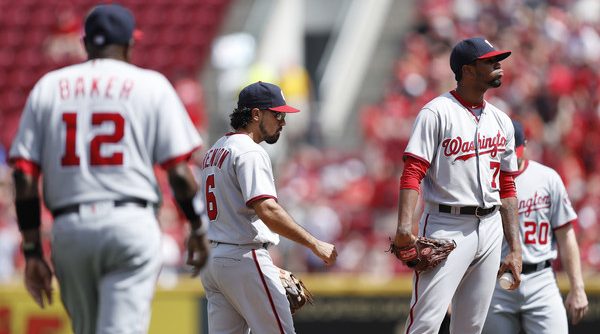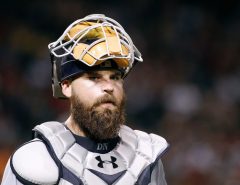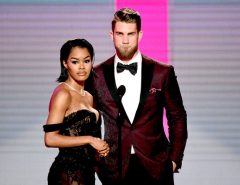Much speculation has swirled around the Nationals potentially acquiring a reliever to beef up the back end of their bullpen. They are frequently named as a suitor for the Yankees’ pair of fireballing lefties: Aroldis Chapman and Andrew Miller. The list doesn’t end there, with Sean Doolittle, Fernando Abad, Jeremy Jeffress, and Alex Colome as members of a very deep group. Suffice it to say, there are quite a few ways the trade deadline could go.
But the Nationals have a pretty good (and deep) bullpen right now, and a trade could leave a worthy reliever on the outside looking in. So let’s take an accounting of the current relievers and see who might be pushed aside if and when the Nationals acquire another arm. I’ll kick it off with some of the locks.
First, Jonathan Papelbon. He was much maligned at the beginning of the season, but a strong string of outings after his return from the DL suddenly has him with a 2.73 ERA and 3.02 FIP. He is only a candidate to be replaced in the closer’s role by virtue of the excellent relievers who the Nationals might add. He has been reliable, and having previously closed out a World Series, is not a threat to wilt in the playoffs like Drew Storen. But he only agreed to join the Nationals at the trade deadline last season in exchange for a promise that he would be closer, and it remains unclear how he would handle a demotion. Dusty Baker is as well-equipped to smooth things over as any manager in baseball, but that task could prove challenging even for him.
Next up is Yusmeiro Petit. Once a Nationals bugaboo for throwing six scoreless innings of relief in the brutal 18-inning loss that Game 2 of the 2014 NLDS became, Petit has been a stellar long man. His 2.56 ERA is far ahead of his 4.32 FIP, and his 91.8% strand rate screams out for regression, but Petit’s value lies primarily in his ability to pitch for long stretches if needed. Even if his ERA were a run and a half higher, he would still be an integral part of this bullpen.
Shawn Kelley has been perhaps the most effective Nats reliever. He did not allow a run into May and has seen his ERA slip to 2.60 since, but if that mark weren’t good enough on its own, his peripherals are even better. He strikes out a jaw-dropping 13.76 batters per nine innings, and pairs that with a paltry 1.82 walks per nine. His 2.21 FIP is splendid, and he looks to remain entrenched as a setup man no matter who joins the team.
Sammy Solis is another surprise contributor to the relief corps. After starting the year in Triple-A, he has thrown nearly 30 innings of 2.43 ERA ball in the majors. The hard-throwing lefty rakes in the strikeouts, with more than 10 per nine innings. The box score will tell you he walks too many batters, but he has not had control issues in his minor league career, walking just 2.4 batters per nine. His numbers are also inflated by a three-walk game in his most recent start, one in which it seems he was injured. But that the Nationals delayed putting him on the DL for 10 days indicates that his knee inflammation is not too serious. If healthy, Solis has established himself as a high-leverage lefty. If not, it creates one more spot on the bubble for one of the next few relievers.
Somewhat of a surprise inclusion on this list is Blake Treinen, whose numbers are quite good despite the fact that each of his outings feels trying. He has kept up his strikeout rate from last year while cutting his walks, though the number of free passes (3.82 per nine) is still far too high. Long known as a ground-baller, Treinen has taken his worm-burning game to new heights this season, getting grounders on 67% of balls in play against him this year. Lefties still crush him, but he has two overpowering abilities: getting ground balls and retiring righties. That perfectly suits him for the role Baker has placed him in: facing righties with a man on first and less than two outs in order to induce a double play. A combination of favorable situations and luck (an 89.1% strand rate) has given him a 2.15 ERA, but bad home run luck (a 19% home run/fly ball percentage) may mean his 3.90 FIP is too high. The truth, as always, lies somewhere in the middle: Treinen is not a 2.15 ERA pitcher, but in a favorable role, he is not a 3.90 FIP pitcher either. He plays an important role in this bullpen.
The five pitchers above seem highly likely to stay on the roster, assuming health. Given a seven-man bullpen, a trade would leave just one spot for the following three relievers.
Felipe Rivero’s profile is similar to Solis’: hard-throwing lefty with strikeout secondaries. But one number jumps out on his FanGraphs page: his sky-high 4.74 ERA, especially in contrast to his 3.34 FIP. His 61.2% strand rate argues that he has simply been unlucky, but a season’s worth of watching him indicates that he can get gassed and lose his edge at times. That could be a product of overuse, a problem that may be ameliorated now that his burden has been lightened and he is touching 98 and 99 now. But if the issue is mechanical or mental, the Nationals could option Rivero to the minors after acquiring a new pitcher. That would also have the added benefit of preserving the team’s bullpen depth, something that would not be possible with pitchers that would need to be designated for assignment to be removed from the roster.
Oliver Perez is much the same: A lefty who gets lots of strikeouts but walks his fair share of hitters too. His 4.91 ERA is the highest on the team, but a 3.59 FIP is perfectly palatable for the second or third lefty in a bullpen. His strand rate is a spot low and his BABIP allowed 40 points higher than his career average, but those factors alone may not explain the run-and-a-half gap between his ERA and FIP. He’s guaranteed $7 million between this year and next, so that alone may keep him around, but if the Nats acquire another lefty and are concerned about Perez, he could be gone in favor of some pitchers who have performed better this season.
In what is an odd situation, the reliever with the lowest ERA on the Nationals is also the one with the loosest grip on his roster spot. Matt Belisle may have been near getting kicked off the team when the Nationals extended his rehab stint long beyond what he needed, but he was fortunate that Papelbon suffered an injury before his clock ran out. He has a 2.14 ERA, and his strikeout and walk rates are both better than his career averages. His FIP is identical to Papelbon’s at 2.73, but he has allowed home runs on just 4.5% of his fly balls, a rate less than half of his career mark. His low ERA is explained by a high strand rate, but even with that, he seems to be a serviceable middle reliever. But the Nationals have plenty of those, and with a slim salary, he could be on the outside looking in.
My prediction: The Nationals trade for a high-leverage guy, perhaps displacing Papelbon. But an injury, or a Belisle-esque extension of Solis’ rehab stint, keeps one spot clear enough for the Nationals to keep up Rivero and Perez. With Koda Glover, Matt Grace, Rafael Martin, and (after he returns from the disabled list) Trevor Gott at Triple A, plus Reynaldo Lopez as a potential relief option as he approaches his innings limit, the Nationals can afford to part with Belisle, hopefully dealing him for a prospect before the deadline hits.
Tags: Blake Treinen, Felipe Rivero, Jonathan Papelbon, Matt Belisle, Nationals, Nats, Oliver Perez, Sammy Solis, Shawn Kelley, Washington Nationals, Yusmeiro Petit




Leave a Reply